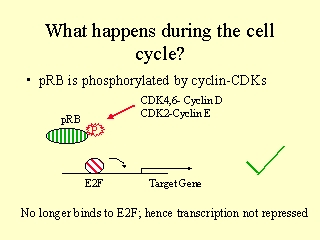

Oncogenes
Al Knudsen (Cal Tech)
Idea that there was a cancer causing gene
proposed
Looked at 100 families for Rb (cancer of the
eye)
R L
Family A
- -
B
+ -
C
+ +
Postulated that there was an element of
inheritance
ie the ability to not get Rb was
inherited in a dominant fashion
the ability to get Rb was
inherited in a recessive fashion
Bob
Weinberg
1985
Isolated and cloned the Rb gene
Showed that they problem was a result of a
deletion
Rb+ = wt
Rb- = mutant (deletion)
Rb is a tumor suppressor (act likes the
brakes)
p 16 is another example of a brake (T.S gene)
Knowing this we can see that there are two
main families of genes at work here
1.
Oncogenes
2.
Tumor Suppressor Genes (TSG)
Rb acts like the gatekeeper
ie that one mutation will lead to an adverse
effect (cancer)
Cells have gone from
Hyperplastic---------------adenoma-----------carcinoma-------------metastasis


Note
·
Rb needs to be unattached for E2F
to work
·
Therefore in the G1 phase E2F is
off
·
Phos-ate Rb to release it from E2F
·
CDK/Cyclin D/Rb/E2F
p53
• A tumor suppressor gene
• implicated in over 50% of cancers
• “Guardian of the Genome”
• “Cellular Gatekeeper”

Mutations in p53
• “Hotspots” are regions where mutations appear to occur more frequently
• In p53 sequenced from cancer cells, many mutations are in DNA binding domain
Checks integrity of the DNA that is
about to be replicated. Checkpoint 1
Is the DNA worth repairing if there
are mutations
If yes allows replication
If not Apoptosis
So what is going on to allow tumor
cells to form?
KO Rb
therefore E2F constantly on DNA
----replication
Regardless of p53 checking
p53 protein of the year
if KO p53 = no brakesClasses of
oncogene
Lung Cancer
Review of E2F regulation via Rb
p53
p53 has a multitude of functions within the cell
There are 3 major functions that it is involved with inside the cell.


| p53 is a tumor
suppressor protein, also known as "Guardian of the Genome". It
plays an important role in cell cycle control and apoptosis.
Defective p53 could allow abnormal cells to proliferate, resulting
in cancer. As many as 50% of all human tumors contain p53 mutants. In normal cells, the p53 protein level is low. DNA damage and other stress signals may trigger the increase of p53 proteins, which have three major functions: growth arrest, DNA repair and apoptosis (cell death). The growth arrest stops the progression of cell cycle, preventing replication of damaged DNA. During the growth arrest, p53 may activate the transcription of proteins involved in DNA repair. Apoptosis is the "last resort" to avoid proliferation of cells containing abnormal DNA. The cellular concentration of p53 must be tightly regulated. While it can suppress tumors, high level of p53 may accelerate the aging process by excessive apoptosis |
|
Target Genes p53 is a transcriptional activator, regulating the expression of genes involved in growth arrest, DNA repair and apoptosis. Some important examples are listed below.
|
|
Roles of p53 The role of p53 is also directly involved in DNA repair. One of its transcriptional target gene, p53R2, encodes ribonucleotide reductase, which is important for both DNA replication and repair. p53 also interacts directly with AP endonuclease and DNA polymerase which are involved in base excision repair. |
How does p53 exert its function?
p21 = major block for cyclin D
p16 = blocks prolife pathway ras---erk---akt
KO. of p53 in mice will not lead to immediate death
This is due to back-up genes that come into play to try and pick up the slack
p127, p67 = p53-like
Not all cells express homologues of p53
Q. What does this imply?
Structure of p53
![]()
Members
of Li-Fraumeni cancer-prone families were shown to carry germ-line p53
mutations. The importance of these observations was underscored by the finding
that mice that are homozygous null for p53, although developmentally
competent, are highly predisposed to tumors.
Knowing this we can see that there are two
main families of genes at work here
1.
Oncogenes
2.
Tumor Suppressor Genes (TSG)
Gatekeeper
Caretaker
P 53 as a caretaker
P 53 Roles